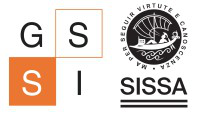Ginzburg-Landau Theory of Superconductivity
Michele Correggi
Politecnico di Milano
The first part of the mini-course is devoted to a rather elementary introduction to the Ginzburg-Landau (GL) theory of superconductivity for extreme type-II superconductors: we first discuss the typical mathematical setting and formulate the GL theory as a suitable variational problem; next, we prove simple properties of the model about, e.g., the existence of minimizers, the response to an external magnetic field, the occurrence of phase transitions marked by critical values of the field, etc.. The second part of the course is more focused on the regime of surface superconductivity, i.e., for magnetic fields between the second and third critical values, when the superconducting behavior survives only at the boundary of the sample. We describe the salient features of the phenomenon and prove the leading order energy and density asymptotics. Furthermore, we show how to prove that superconductivity is uniform in the surface layer and we identify the corrections induced by boundary curvature. Finally, we consider domains with corner singularities at the boundary and briefly discuss the associated effects.
References:
- M. Correggi, Surface Effects in Superconductors with Corners, preprint arXiv:2003.00521.
- S. Fournais, B. Helffer, Spectral Methods in Surface Superconductivity, Progress in Nonlinear Differential Equations and their Applications 77, Birkhauser, Basel, 2010.
- E. Sandier, S. Serfaty, Vortices in the Magnetic Ginzburg-Landau Model, Progress in Nonlinear Differential Equations and their
Applications 70, Birkhauser, Basel, 2007.
Derivation of the Ginzburg-Landau functional:
- R. L. Frank, C. Hainzl, R. Seiringer, J.P. Solovej. Microscopic derivation of the Ginzburg-Landau theory. J. Am. Math. Soc. 25 (3), 2012, 667-713.
- L.P. Gor'kov, Microscopic derivation of the Ginzburg-Landau equations in the theory of superconductivity, Zh. Eksp. Teor. Fiz. 36, 1918–1923 (1959); English translation Soviet Phys. JETP 9, 1364–1367 (1959).
The scaling limit of non-integrable Ising models
Alessandro Giuliani
Università di Roma Tre e Centro Linceo Interdisciplinare Beniamino Segre
The construction of the scaling limit of critical statistical mechanics models is an important challenge of mathematical statistical mechanics. Not only the limit is expected to exist for essentially any reasonable short-range model at the critical point, but it is expected to have remarkable properties, including `universality' with respect to irrelevant perturbations of the microscopic Hamiltonian, and conformal covariance with respect to geometric deformations of the domain. In this mini-course I will review recent advances in the rigorous understanding of universality of the scaling limit and its conformal covariance for a class of non-integrable, or non-planar, Ising models in two dimensions. I will focus on the construction of the scaling limit of the multi-point energy correlations in the cylinder, based on constructive Renormalization Group (RG) methods. The systematic analysis of the effect of the boundary corrections to the RG flow, to be discussed in the two lectures, opens the way to several other developments, such as the computation of the universal subleading corrections to the critical free energy and of the boundary critical exponents in non-integrable Ising, dimer and vertex models in two dimensions, which I will comment about. Based on joint works with G. Antinucci, R. Greenblatt and V. Mastropietro.
Most of the material presented in the course will be related to the paper:
"Energy correlations of non-integrable Ising models: The scaling limit in the cylinder"
by G. Antinucci, A. Giuliani, R. L. Greenblatt,
available at https://arxiv.org/abs/2006.04458
Two earlier papers whose results will be discussed in the course are:
"The scaling limit of the energy correlations in non integrable Ising models"
by A. Giuliani, R.L. Greenblatt, V. Mastropietro, J. Math. Phys. 53, 095214 (2012),
available at https://arxiv.org/abs/1204.4040
"Universal finite size corrections and the central charge in non solvable Ising models"
by A. Giuliani, V. Mastropietro, Comm. Math. Phys. 324, 179-214 (2013),
available at https://arxiv.org/abs/1211.3030
For a review of the constructive RG methods presented in the course, see also
"Renormalization Group for One-Dimensional Fermions. A Review on Mathematical Results"
by G. Gentile, V. Mastropietro, Physics Reports 352 (2001) 273-437,
available at http://ricerca.mat.uniroma3.it/ipparco/pagine/deposito/2000/main.ps.gz
Stochastic Quantization
Massimiliano Gubinelli
University of Bonn
Introduced in the '80 by Parisi and Wu, stochastic quantisation is an approach to the construction of (Euclidean) quantum field theories (QFTs) which relies on stochastic partial differential equations. In this minicourse I will explain recent progresses in the rigorous implementation of this program (in the context of the $\Phi^4_3$ model) which leverages techniques from analysis and probability. We will start by briefly introducing the general goal of bosonic constructive quantum field theory and how this translate into the construction of specific probability measures on very irregular random fields, we will then go on to show how these probability distributions can be understood as invariant measures of stochastic dynamics of Langevin type in infinitely many variables. This will bring us to give a look at singular stochastic partial differential equations and their renormalization and how to control both the short scale and the large scale behaviour and (if time permits) how to obtain certain properties of the Euclidean QFT from the dynamics.
Most of the material presented in the course will be related to the paper:
"A PDE construction of the Euclidean Φ^4_3 quantum field theory"
https://arxiv.org/abs/1810.01700.

